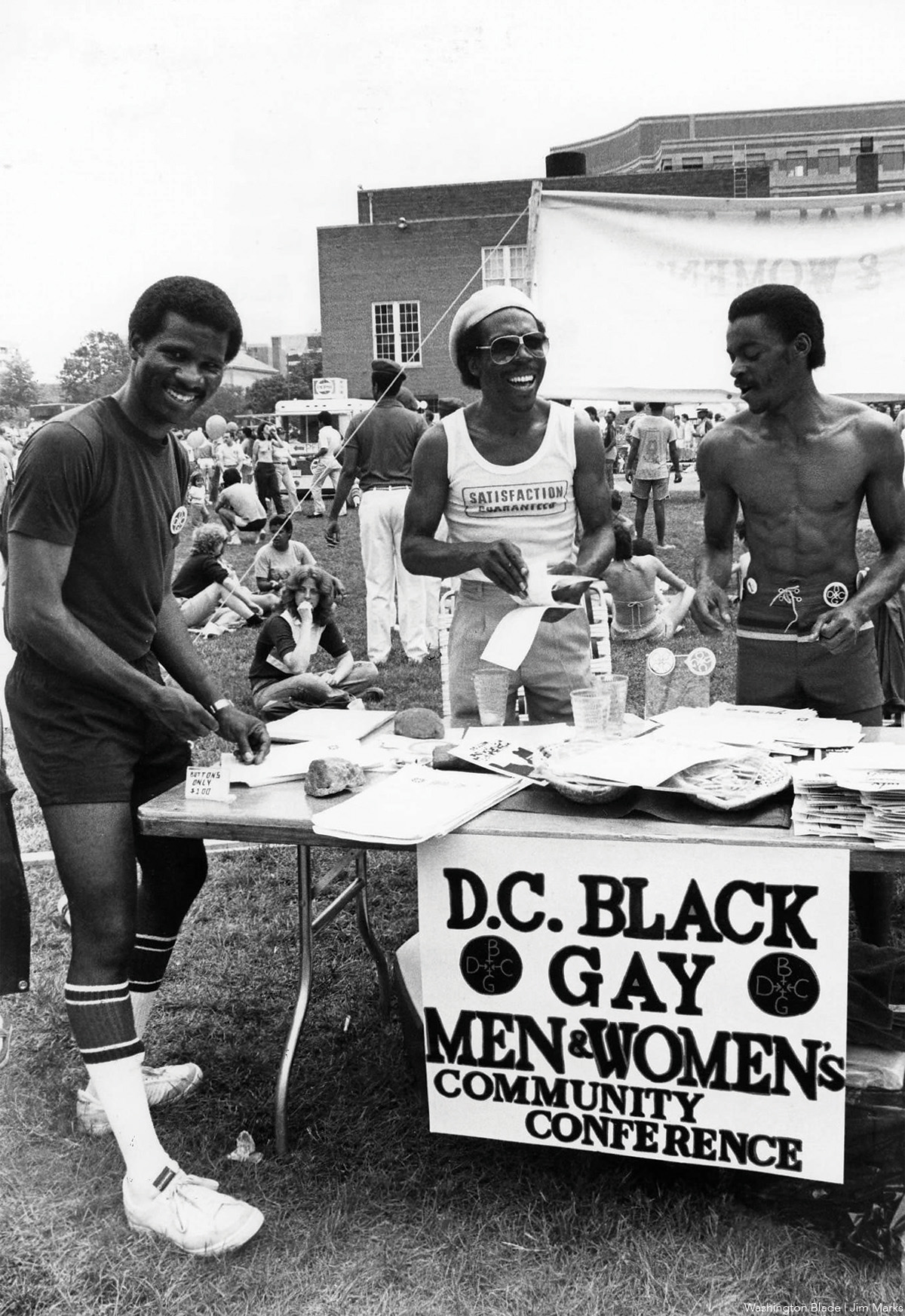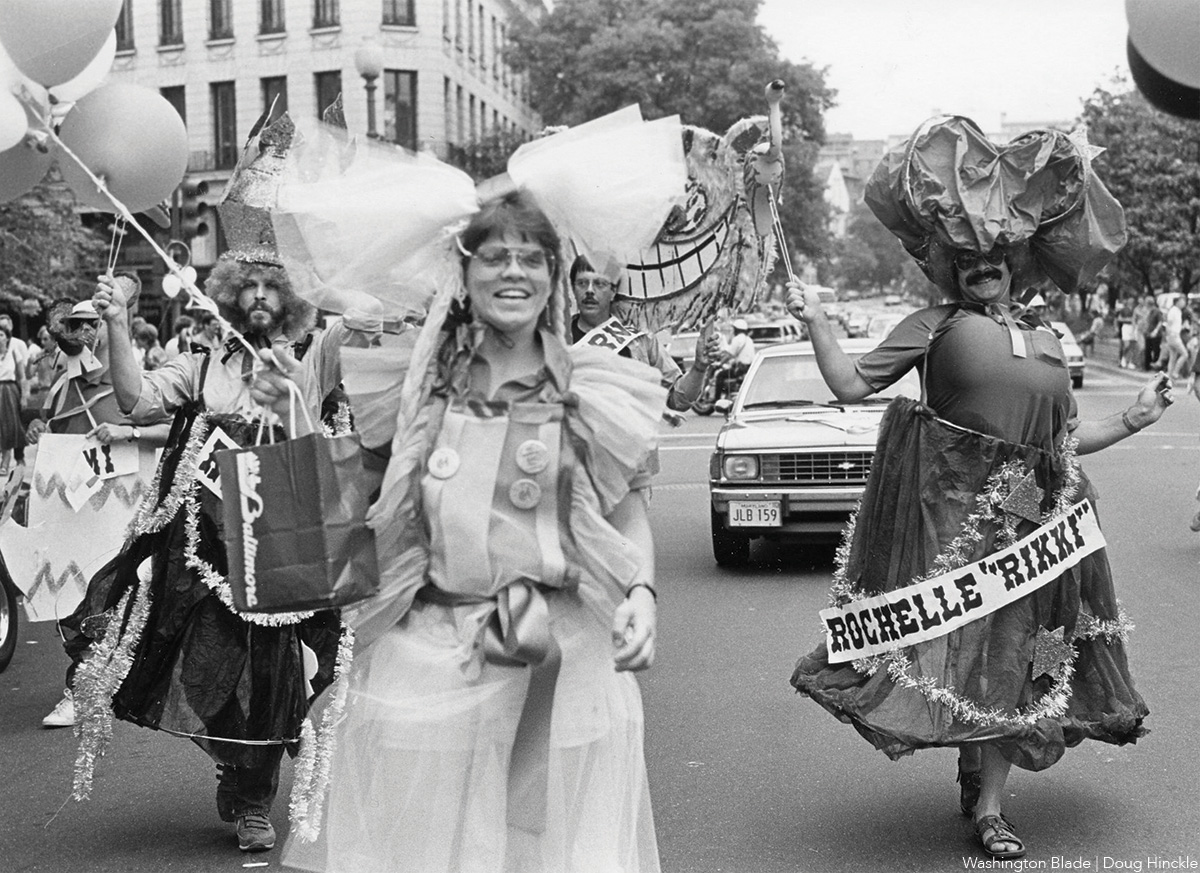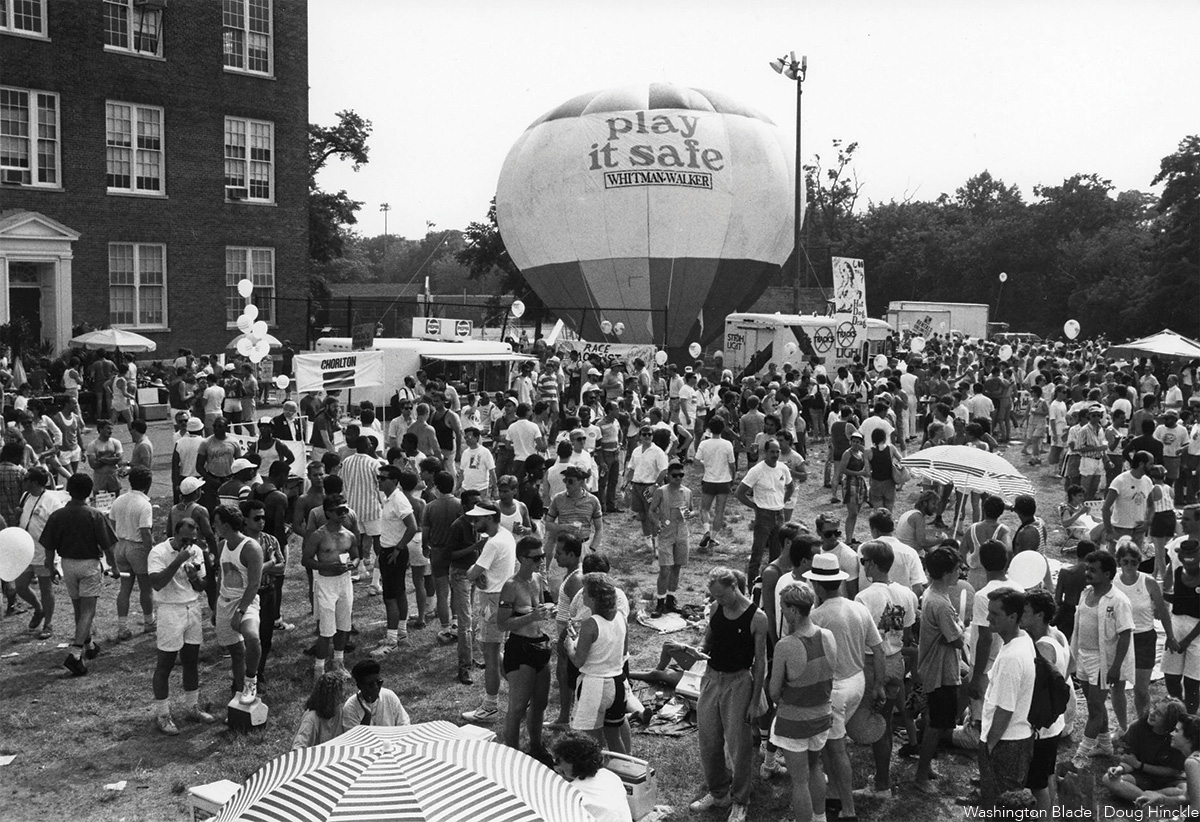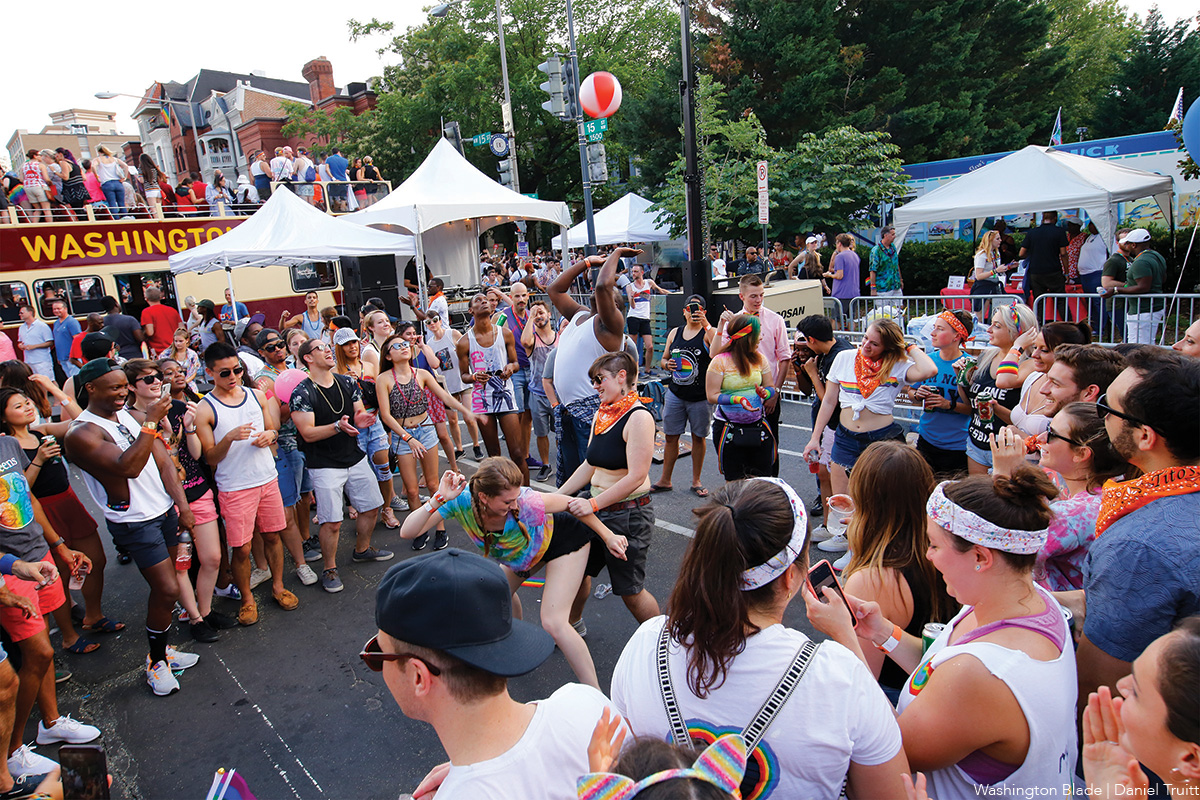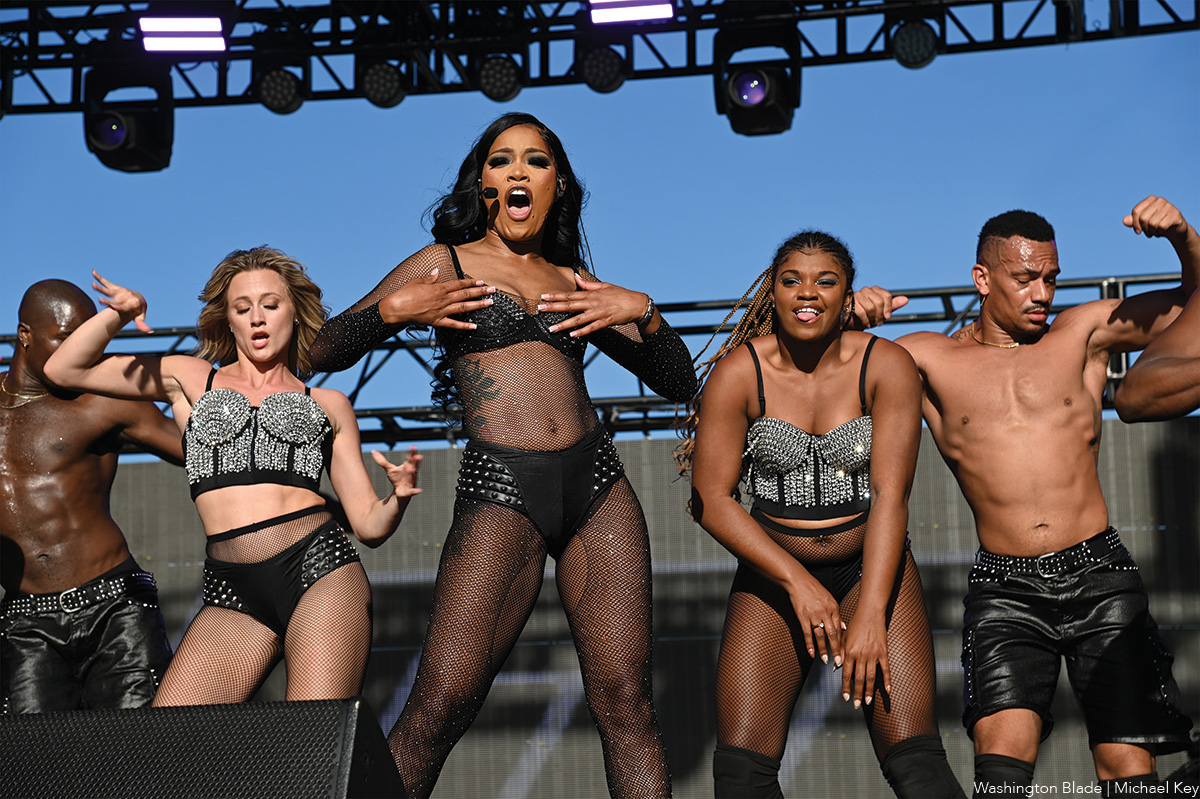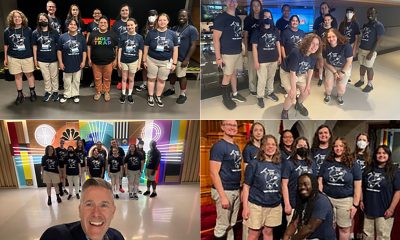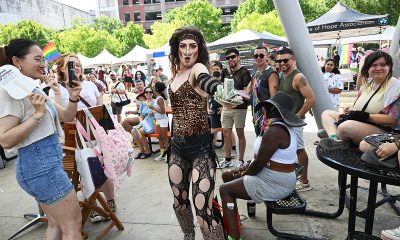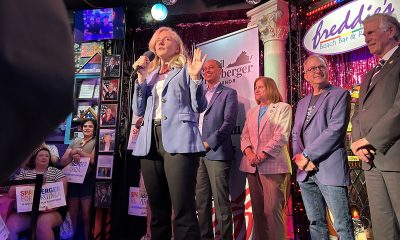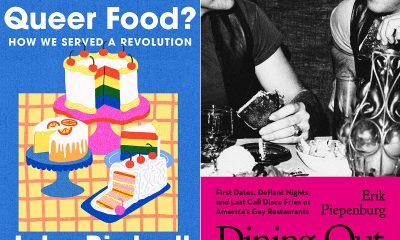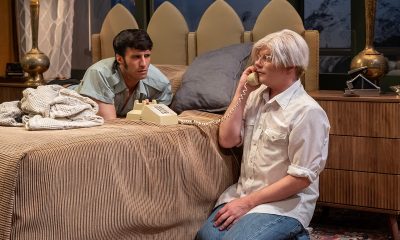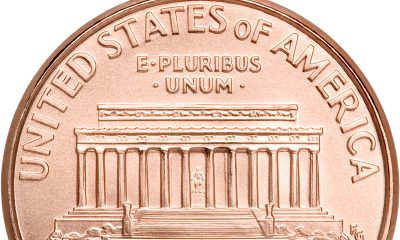a&e features
Baltimore’s Grand Central celebrates 25 years
Jazz, leather, karaoke, drag and more find home at legendary Charm City club
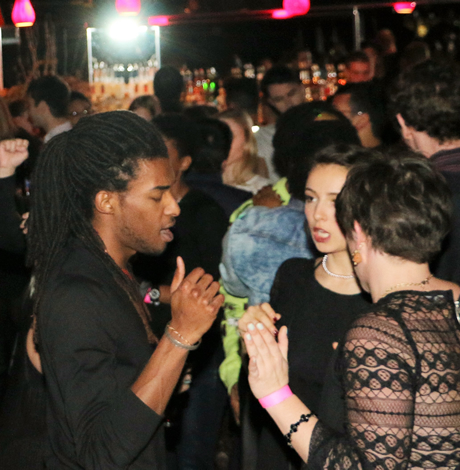
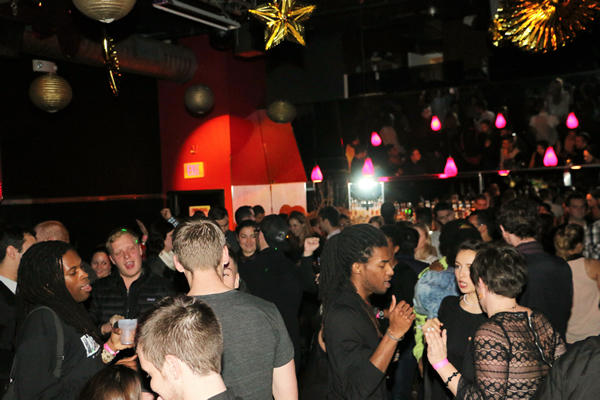
A Grand Central party in 2014. The club has been a central hub of Baltimore gay life since 1991. (Photo by Bob Ford)
RJ Ladd recalls the summer of 2001 at Central Station, the former name of Grand Central. It was during “Tia-Oke” when drag performer, “Tia (Chambers), drunk, hosted karaoke, attempted to walk down the steps and fell flat on her face. We helped her up, not a hair out of place, and she didn’t miss a beat. She kept going as if it didn’t happen.”
That amusing anecdote could serve obliquely as a metaphor for Grand Central Nightclub’s 25-year history. Though the club never stumbled, it has had to overcome a number of challenges —competition, property damage, declining interest in gay bars — to remain a vital part of Baltimore’s LGBT culture and social life.
To mark 25 years in the community, Grand Central, situated at the intersection of Charles and Eager streets in the Mount Vernon gayborhood, will host a special event on Saturday, March 25. There will be free cover all night and giveaways every hour as well as other surprises.
Owner Don Davis, a well-known and outspoken figure in Baltimore’s LGBT community, waxes nostalgic about the era when gay bars were at their zenith. Prior to owning Grand Central, he and partner Rick Morgenthaler had opened the Allegro, also in Mount Vernon, in November 1986. After a slow start, they modified the piano bar format by instituting country and western parties, men’s nights and ladies’ nights.

Grand Central owner Don Davis says he’s overcome many hurdles to keep the business running since it opened 25 years ago. (Photo courtesy Davis)
Those changes paid off. “The place was hopping and became the place to be,” Davis says. “There were a lot of fun memories back then.”
At the time, Davis used to drive down Eager Street en route to his home in the Canton neighborhood. He noticed that a historic row house at 1001 N. Charles Street was for sale.
“I always liked the building and the location and decided to look at it throughout,” Davis says. “I contacted two of my friends and asked if they would be interested in being an investor with no say in the business. They both agreed.”
The property was purchased in July 1991. After renovations, the doors opened on Sept. 12, 1991.
On Feb. 5, 2003, Davis purchased the adjacent north building at 1003 North Charles St. where the former Stagecoach bar existed, and reconstruction was undertaken, adding a double bar disco with state-of-the-art dance floor, sound and lighting systems, and an additional upstairs lounge and restaurant.
In keeping with the major improvements and new facilities, the club was renamed Grand Central and the expanded complex opened May 29, 2003.
Diagonally across the corner was the iconic Club Hippo, for years the largest dance bar in the state. Within a couple of blocks were other well-established bars, the Drinkery and Leon’s. Grand Central was the new kid on the block.
To effectively compete, Davis had to broaden the market and create special events. Billing Grand Central as an “alternative nightclub,” Davis encouraged straight people to patronize the bar.
“I was always grateful for everyone’s business, whether you were straight or gay,” Davis says. “As long as everyone could accept the gay culture, they were welcomed.”
Grand Central had been beset by a couple of odd events. In June 2008, just a week after workers had repaired a storm-damaged roof on the north building, a fire broke out causing damage to the upper floor.
Five years later, a car, which was being pursued by transit police, crashed into a pick-up truck in front of the bar spilling its cargo of white paint all over the exterior and leaving a mess inside the pub. The effects of that incident led to additional renovations.
Each time Grand Central bounced back.
Through the years, Grand Central hosted numerous themed events including red, black and white parties, all well attended. Karaoke nights have been a popular feature as well as jazz, fashion shows and REHAB Saturdays.
Wendy Fox, co-owner of S.H.E. Productions, which has put on events like REHAB at Grand Central for eight years, says, “We are happy to be inclusive of everyone, and the club has always been gracious and open to our ideas, themes and fundraisers.”
An employee for nearly five years, Nicole West says, “Don Davis has always been encouraging and appreciative, the customers always kind and the other staff is like family.”
The upstairs loft has been used for a variety of purposes including receptions, a lesbian-oriented space called Sappho’s for a short time, and it had also been a venue for leather-related events after the Baltimore Eagle (now re-opened) had closed in 2012. The restaurant no longer exists.
The dance club with its two bars is a popular attraction. The Hippo’s closing in 2015 left Grand Central as the leading dance venue in Mount Vernon.
Says DJ Kuhmeleon who used to work at Grand Central, “Being so far away from the crowd in that DJ-in-the-sky, I love hearing the crowd singing every song so loud that it actually rises above the music itself and I can hear them perfectly.”
However, increasing acceptance of LGBT people that allows for comfortably patronizing straight establishments as well as the onset of dating apps have contributed to a decline in gay bars. This concerns Davis.
“Over the past 30 years, I have seen about 29 gay bars and clubs close,” says Davis, 66, who now resides most of the year in Florida.
Notwithstanding that trend, community members see the value of Grand Central.
“I remember 15 years ago, I had the courage to step into a gay bar for the first time and Grand Central welcomed me with open arms,” says photographer Robert Mercer, Jr. “It was like home and the community embraced me without judgment.”
Adds Brian Dolbow, an advocate for the homeless, “Grand Central was the first bar I visited when I moved to Baltimore in 2003. I immediately loved the welcoming atmosphere. In addition, Grand Central has always been supportive of my charity work.”
“Historically, Grand Central has been a welcome place for patrons of all gender, identity and sexual orientations with a variety of offerings including dance, jazz, karaoke, leather and a vibrant bar scene,” says Bob Glock, general manager of the nearby Hotel Brexton. “It has been a major draw to not only the Mount Vernon community, but to Baltimore generally for those outside of the city looking for a safe and sophisticated alternative bar scene.”
Brian Gaither, co-founder of Pride Foundation of Maryland, acknowledges that Grand Central is a landmark institution.
“Over the years it’s provided a safe space for our community and has been a major supporter of LGBT events and organizations,” Gaither says. “We are grateful for all they have done.”
As for himself, Davis is appreciative of the support Baltimore has given to Grand Central.
“Without good staff and the support over the 25 years it would have not been possible,” he says. “Thank you, Baltimore.”
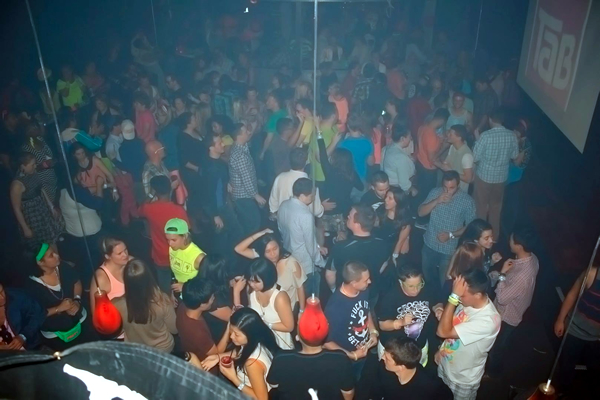
Revelers at an Electric Youth party at Grand Central in 2013. (Photo courtesy Grand Central)
a&e features
Visit Cambridge, a ‘beautiful secret’ on Maryland’s Eastern Shore
New organization promotes town’s welcoming vibe, LGBTQ inclusion
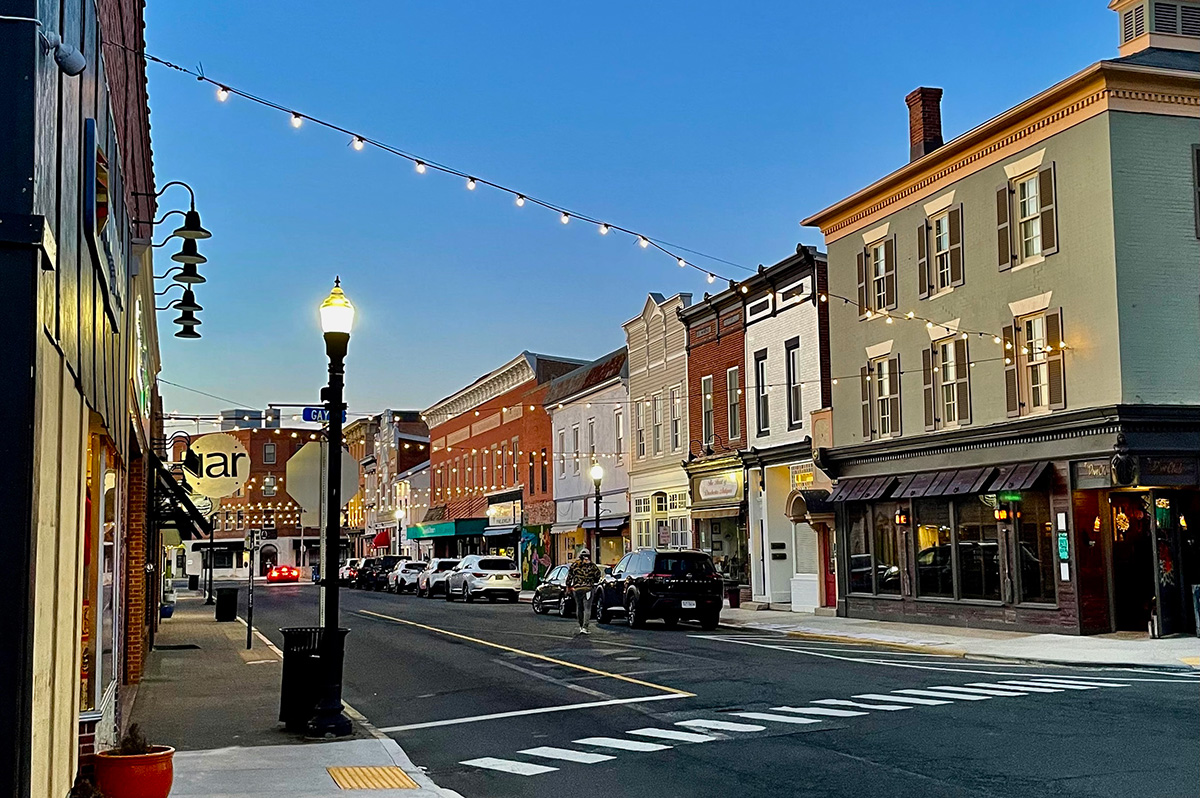
CAMBRIDGE, Md. — Driving through this scenic, historic town on Maryland’s Eastern Shore, you’ll be charmed by streets lined with unique shops, restaurants, and beautifully restored Victorian homes. You’ll also be struck by the number of LGBTQ Pride flags flying throughout the town.
The flags are a reassuring signal that everyone is welcome here, despite the town’s location in ruby red Dorchester County, which voted for Donald Trump over Kamala Harris by a lopsided margin. But don’t let that deter you from visiting. A new organization, Proudly Cambridge, is holding its debut Pride event this weekend, touting the town’s welcoming, inclusive culture.
“We stumbled on a beautiful secret and we wanted to help get the word out,” said James Lumalcuri of the effort to create Proudly Cambridge.
The organization celebrates diversity, enhances public spaces, and seeks to uplift all that Cambridge has to share, according to its mission statement, under the tagline “You Belong Here.”
The group has so far held informal movie nights and a picnic and garden party; the launch party is June 28 at the Cambridge Yacht Club, which will feature a Pride celebration and tea dance. The event’s 75 tickets sold out quickly and proceeds benefit DoCo Pride.
“Tickets went faster than we imagined and we’re bummed we can’t welcome everyone who wanted to come,” Lumalcuri said, adding that organizers plan to make “Cheers on the Choptank” an annual event with added capacity next year.
One of the group’s first projects was to distribute free Pride flags to anyone who requested one and the result is a visually striking display of a large number of flags flying all over town. Up next: Proudly Cambridge plans to roll out a program offering affirming businesses rainbow crab stickers to show their inclusiveness and LGBTQ support. The group also wants to engage with potential visitors and homebuyers.
“We want to spread the word outside of Cambridge — in D.C. and Baltimore — who don’t know about Cambridge,” Lumalcuri said. “We want them to come and know we are a safe haven. You can exist here and feel comfortable and supported by neighbors in a way that we didn’t anticipate when we moved here.”
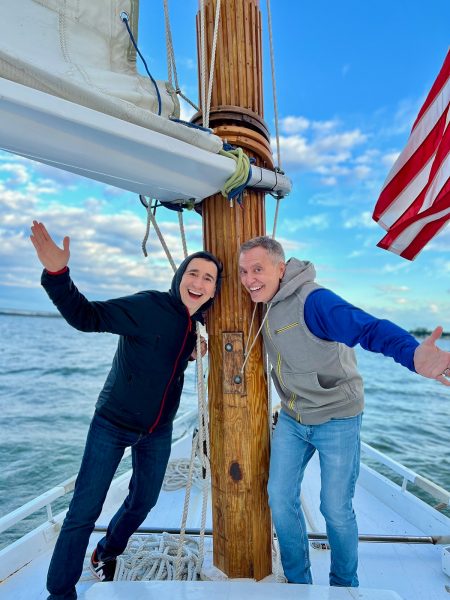
Lumalcuri, 53, a federal government employee, and his husband, Lou Cardenas, 62, a Realtor, purchased a Victorian house in Cambridge in 2021 and embarked on an extensive renovation. The couple also owns a home in Adams Morgan in D.C.
“We saw the opportunity here and wanted to share it with others,” Cardenas said. “There’s lots of housing inventory in the $300-400,000 range … we’re not here to gentrify people out of town because a lot of these homes are just empty and need to be fixed up and we’re happy to be a part of that.”
Lumalcuri was talking with friends one Sunday last year at the gazebo (affectionately known as the “gayzebo” by locals) at the Yacht Club and the idea for Proudly Cambridge was born. The founding board members are Lumalcuri, Corey van Vlymen, Brian Orjuela, Lauren Mross, and Caleb Holland. The group is currently working toward forming a 501(c)3.
“We need visibility and support for those who need it,” Mross said. “We started making lists of what we wanted to do and the five of us ran with it. We started meeting weekly and solidified what we wanted to do.”
Mross, 50, a brand strategist and web designer, moved to Cambridge from Atlanta with her wife three years ago. They knew they wanted to be near the water and farther north and began researching their options when they discovered Cambridge.
“I had not heard of Cambridge but the location seemed perfect,” she said. “I pointed on a map and said this is where we’re going to move.”
The couple packed up, bought a camper trailer and parked it in different campsites but kept coming back to Cambridge.
“I didn’t know how right it was until we moved here,” she said. “It’s the most welcoming place … there’s an energy vortex here – how did so many cool, progressive people end up in one place?”
Corey van Vlymen and his husband live in D.C. and were looking for a second home. They considered Lost River, W.Va., but decided they preferred to be on the water.
“We looked at a map on both sides of the bay and came to Cambridge on a Saturday and bought a house that day,” said van Vlymen, 39, a senior scientist at Booz Allen Hamilton. They’ve owned in Cambridge for two years.
They were drawn to Cambridge due to its location on the water, the affordable housing inventory, and its proximity to D.C.; it’s about an hour and 20 minutes away.
Now, through the work of Proudly Cambridge, they hope to highlight the town’s many attributes to residents and visitors alike.
“Something we all agree on is there’s a perception problem for Cambridge and a lack of awareness,” van Vlymen said. “If you tell someone you’re going to Cambridge, chances are they think, ‘England or Massachusetts?’”
He cited the affordability and the opportunity to save older, historic homes as a big draw for buyers.
“It’s all about celebrating all the things that make Cambridge great,” Mross added. “Our monthly social events are joyful and celebratory.” A recent game night drew about 70 people.
She noted that the goal is not to gentrify the town and push longtime residents out, but to uplift all the people who are already there while welcoming new visitors and future residents.
They also noted that Proudly Cambridge does not seek to supplant existing Pride-focused organizations. Dorchester County Pride organizes countywide Pride events and Delmarva Pride was held in nearby Easton two weeks ago.
“We celebrate all diversity but are gay powered and gay led,” Mross noted.
To learn more about Proudly Cambridge, visit the group on Facebook and Instagram.
What to see and do
Cambridge, located 13 miles up the Choptank River from the Chesapeake Bay, has a population of roughly 15,000. It was settled in 1684 and named for the English university town in 1686. It is home to the Harriet Tubman Museum, mural, and monument. Its proximity to the Blackwater National Wildlife Refuge makes it a popular stop for birders, drawn to more than 27,000 acres of marshland dubbed “the Everglades of the north.”
The refuge is walkable, bikeable, and driveable, making it an accessible attraction for all. There are kayaking and biking tours through Blackwater Adventures (blackwateradventuresmd.com).
Back in town, take a stroll along the water and through historic downtown and admire the architecture. Take in the striking Harriet Tubman mural (424 Race St.). Shop in the many local boutiques, and don’t miss the gay-owned Shorelife Home and Gifts (421 Race St.), filled with stylish coastal décor items.
Stop for breakfast or lunch at Black Water Bakery (429 Race St.), which offers a full compliment of coffee drinks along with a build-your-own mimosa bar and a full menu of creative cocktails.
The Cambridge Yacht Club (1 Mill St.) is always bustling but you need to be a member to get in. Snapper’s on the water is temporarily closed for renovations. RaR Brewing (rarbrewing.com) is popular for craft beers served in an 80-year-old former pool hall and bowling alley. The menu offers burgers, wings, and other bar fare.
For dinner or wine, don’t miss the fantastic Vintage 414 (414 Race St.), which offers lunch, dinner, wine tasting events, specialty foods, and a large selection of wines. The homemade cheddar crackers, inventive flatbreads, and creative desserts (citrus olive oil cake, carrot cake trifle) were a hit on a recent visit.
Also nearby is Ava’s (305 High St.), a regional chain offering outstanding Italian dishes, pizzas, and more.
For something off the beaten path, visit Emily’s Produce (22143 Church Creek Rd.) for its nursery, produce, and prepared meals.
“Ten minutes into the sticks there’s a place called Emily’s Produce, where you can pay $5 and walk through a field and pick sunflowers, blueberries, you can feed the goats … and they have great food,” van Vlymen said.
As for accommodations, there’s the Hyatt Regency Chesapeake Bay (100 Heron Blvd. at Route 50), a resort complex with golf course, spa, and marina. Otherwise, check out Airbnb and VRBO for short-term rentals closer to downtown.
Its proximity to D.C. and Baltimore makes Cambridge an ideal weekend getaway. The large LGBTQ population is welcoming and they are happy to talk up their town and show you around.
“There’s a closeness among the neighbors that I wasn’t feeling in D.C.,” Lumalcuri said. “We look after each other.”
a&e features
James Baldwin bio shows how much of his life is revealed in his work
‘A Love Story’ is first major book on acclaimed author’s life in 30 years

‘Baldwin: A Love Story’
By Nicholas Boggs
c.2025, FSG
$35/704 pages
“Baldwin: A Love Story” is a sympathetic biography, the first major one in 30 years, of acclaimed Black gay writer James Baldwin. Drawing on Baldwin’s fiction, essays, and letters, Nicolas Boggs, a white writer who rediscovered and co-edited a new edition of a long-lost Baldwin book, explores Baldwin’s life and work through focusing on his lovers, mentors, and inspirations.
The book begins with a quick look at Baldwin’s childhood in Harlem, and his difficult relationship with his religious, angry stepfather. Baldwin’s experience with Orilla Miller, a white teacher who encouraged the boy’s writing and took him to plays and movies, even against his father’s wishes, helped shape his life and tempered his feelings toward white people. When Baldwin later joined a church and became a child preacher, though, he felt conflicted between academic success and religious demands, even denouncing Miller at one point. In a fascinating late essay, Baldwin also described his teenage sexual relationship with a mobster, who showed him off in public.
Baldwin’s romantic life was complicated, as he preferred men who were not outwardly gay. Indeed, many would marry women and have children while also involved with Baldwin. Still, they would often remain friends and enabled Baldwin’s work. Lucien Happersberger, who met Baldwin while both were living in Paris, sent him to a Swiss village, where he wrote his first novel, “Go Tell It on the Mountain,” as well as an essay, “Stranger in the Village,” about the oddness of being the first Black person many villagers had ever seen. Baldwin met Turkish actor Engin Cezzar in New York at the Actors’ Studio; Baldwin later spent time in Istanbul with Cezzar and his wife, finishing “Another Country” and directing a controversial play about Turkish prisoners that depicted sexuality and gender.
Baldwin collaborated with French artist Yoran Cazac on a children’s book, which later vanished. Boggs writes of his excitement about coming across this book while a student at Yale and how he later interviewed Cazac and his wife while also republishing the book. Baldwin also had many tumultuous sexual relationships with young men whom he tried to mentor and shape, most of which led to drama and despair.
The book carefully examines Baldwin’s development as a writer. “Go Tell It on the Mountain” draws heavily on his early life, giving subtle signs of the main character John’s sexuality, while “Giovanni’s Room” bravely and openly shows a homosexual relationship, highly controversial at the time. “If Beale Street Could Talk” features a woman as its main character and narrator, the first time Baldwin wrote fully through a woman’s perspective. His essays feel deeply personal, even if they do not reveal everything; Lucian is the unnamed visiting friend in one who the police briefly detained along with Baldwin. He found New York too distracting to write, spending his time there with friends and family or on business. He was close friends with modernist painter Beauford Delaney, also gay, who helped Baldwin see that a Black man could thrive as an artist. Delaney would later move to France, staying near Baldwin’s home.
An epilogue has Boggs writing about encountering Baldwin’s work as one of the few white students in a majority-Black school. It helpfully reminds us that Baldwin connects to all who feel different, no matter their race, sexuality, gender, or class. A well-written, easy-flowing biography, with many excerpts from Baldwin’s writing, it shows how much of his life is revealed in his work. Let’s hope it encourages reading the work, either again or for the first time.
a&e features
Looking back at 50 years of Pride in D.C
Washington Blade’s unique archives chronicle highs, lows of our movement
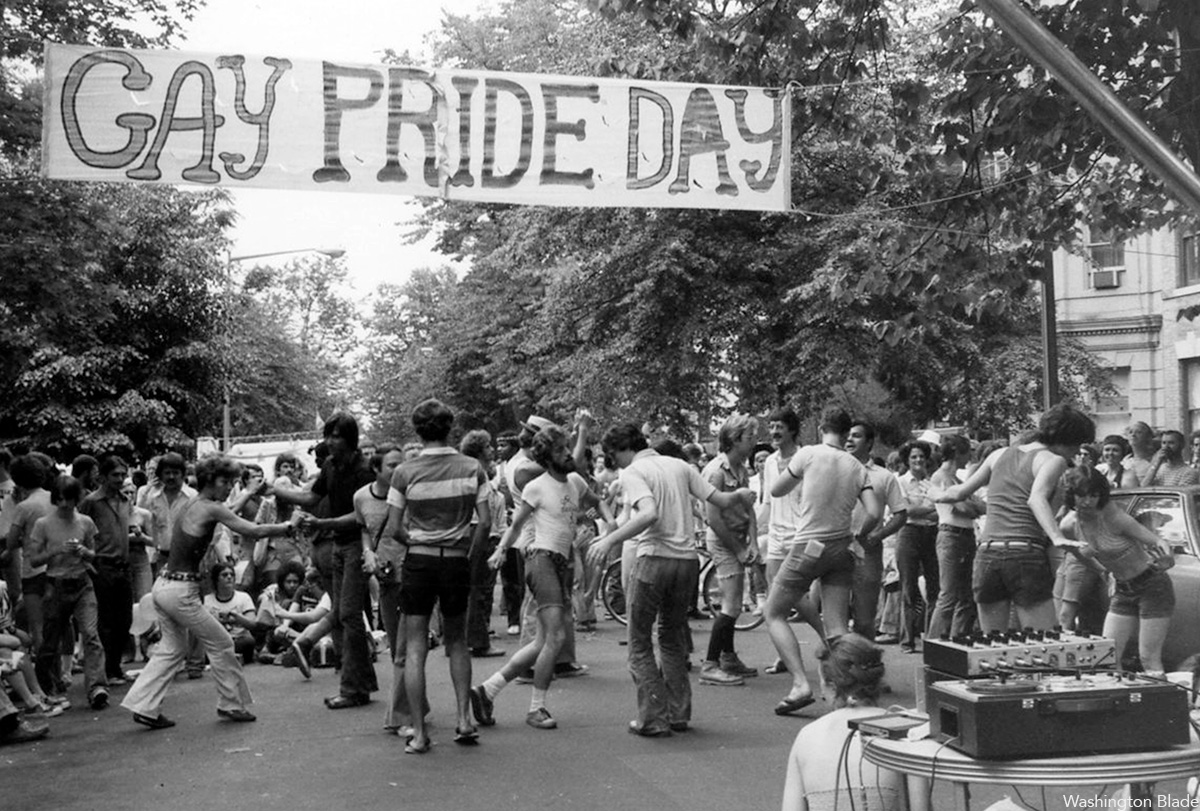
To celebrate the 50th anniversary of LGBTQ Pride in Washington, D.C., the Washington Blade team combed our archives and put together a glossy magazine showcasing five decades of celebrations in the city. Below is a sampling of images from the magazine but be sure to find a print copy starting this week.
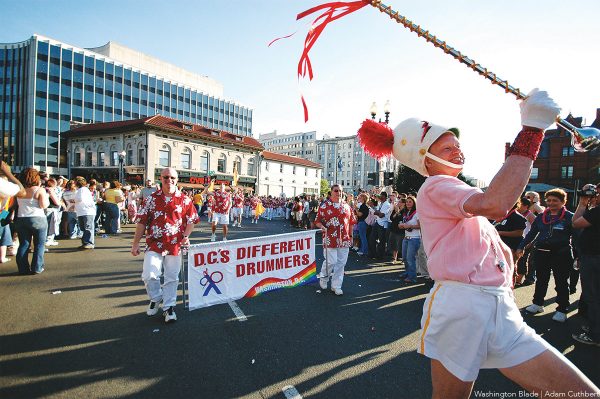
The magazine is being distributed now and is complimentary. You can find copies at LGBTQ bars and restaurants across the city. Or visit the Blade booth at the Pride festival on June 7 and 8 where we will distribute copies.
Thank you to our advertisers and sponsors, whose support has enabled us to distribute the magazine free of charge. And thanks to our dedicated team at the Blade, especially Photo Editor Michael Key, who spent many hours searching the archives for the best images, many of which are unique to the Blade and cannot be found elsewhere. And thanks to our dynamic production team of Meaghan Juba, who designed the magazine, and Phil Rockstroh who managed the process. Stephen Rutgers and Brian Pitts handled sales and marketing and staff writers Lou Chibbaro Jr., Christopher Kane, Michael K. Lavers, Joe Reberkenny along with freelancer and former Blade staffer Joey DiGuglielmo wrote the essays.
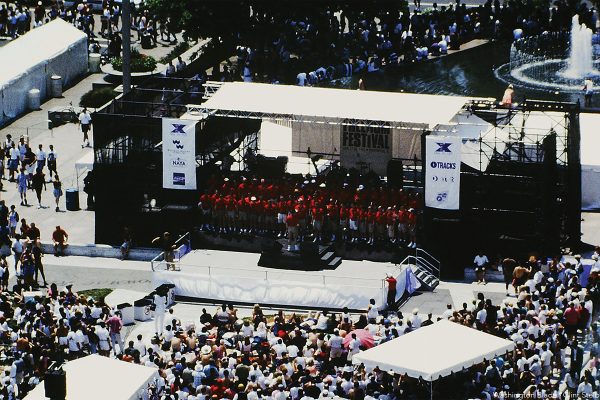
The magazine represents more than 50 years of hard work by countless reporters, editors, advertising sales reps, photographers, and other media professionals who have brought you the Washington Blade since 1969.
We hope you enjoy the magazine and keep it as a reminder of all the many ups and downs our local LGBTQ community has experienced over the past 50 years.
I hope you will consider supporting our vital mission by becoming a Blade member today. At a time when reliable, accurate LGBTQ news is more essential than ever, your contribution helps make it possible. With a monthly gift starting at just $7, you’ll ensure that the Blade remains a trusted, free resource for the community — now and for years to come. Click here to help fund LGBTQ journalism.
